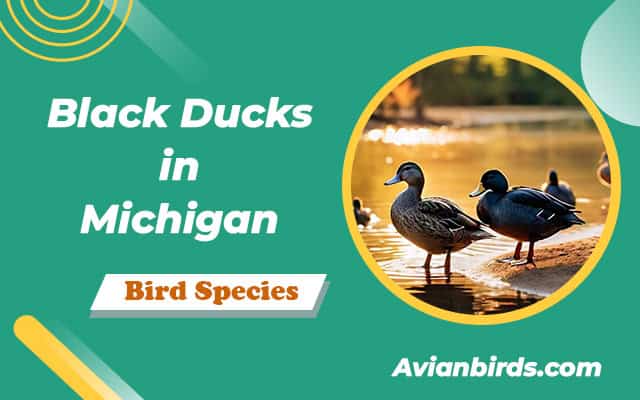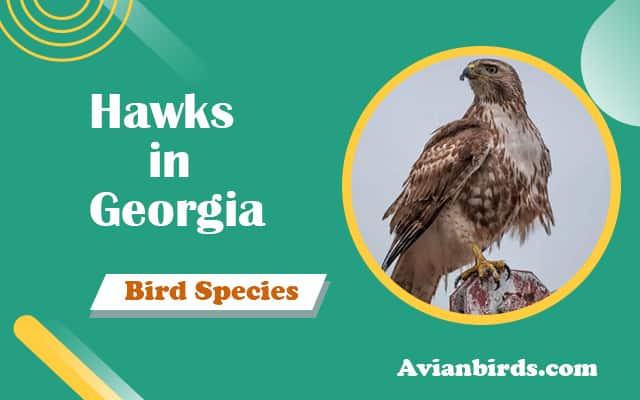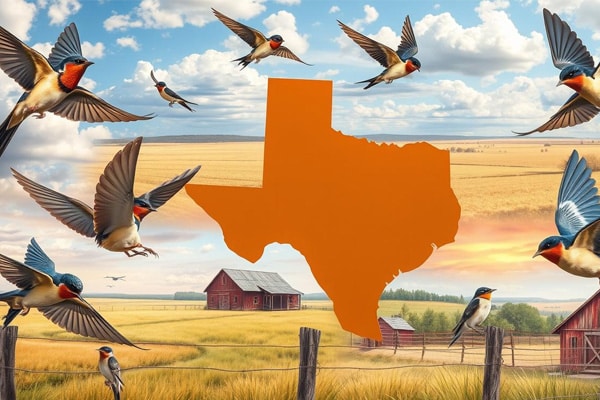Top 10 Hawks Species in San Diego (With Pictures)
San Diego County is home to over 20 species of raptors, including some of the most stunning hawks in the country. This variety makes birdwatching here thrilling for both experts and beginners. We’ll look at the top ten hawk species in San Diego, showing their beauty and their important roles in our ecosystems.
From the soaring Red-tailed Hawk to the elusive Zone-tailed Hawk, these hawks are key to nature’s balance. We encourage readers to learn about their unique features and habitats. These birds make our environment richer.
What kind of Hawks are in San Diego
- Red-tailed Hawk
- Cooper’s Hawk
- Sharp-shinned Hawk
- Swainson’s Hawk
- Northern Harrier
- Ferruginous Hawk
- Red-shouldered Hawk
- Zone-tailed Hawk
1. Red-tailed Hawk
- Scientific Name: Buteo jamaicensis
- Size: 45–65 cm (18–26 in)
- Weight: 0.9–2.3 kg (2–5.1 lb)
- Diet: Small mammals, birds, and reptiles.
The Red-tailed Hawk is a key bird of prey in North America. It is known for its striking looks and plays a vital role in our ecosystems. Learning how to identify this hawk can deepen our respect for it.

Physical Characteristics
Adult Red-tailed Hawks are 18 to 26 inches long and have wings that stretch from 43 to 57 inches wide. Their reddish-brown tail feathers easily recognize them. Adults are mostly one color, but young ones have a mix of browns. This makes them interesting spots for bird watchers.
Habitat and Diet
Red-tailed Hawks live in many places, from forests to cities. They like to sit on tall poles or trees, watching for food. They mainly eat small mammals like rodents. Plus, They also hunt reptiles and smaller birds if they can.
Their hunting skills and unique call make them top predators in their homes.
2. Cooper’s Hawk
- Scientific Name: Accipiter cooperii
- Size: 38–51 cm (15–20 in)
- Weight: 0.5–1.2 kg (1.1–2.6 lb)
- Diet: Small birds, particularly songbirds.
The Cooper’s Hawk is a great example of how animals adapt. It has special traits and lives in places that help it hunt well.
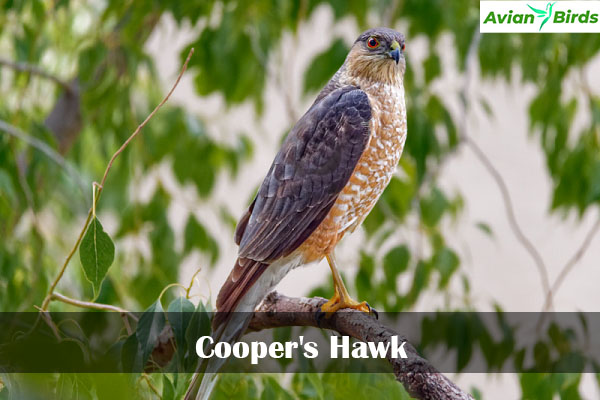
Identifying Features
The Cooper’s Hawk is medium-sized, 14 to 20 inches long, with a wingspan of 24 to 39 inches. Its sleek body makes it agile in the air. Its top feathers are a beautiful blue-gray, while the underside is reddish-brown. These looks help it sneak up on prey in trees.
Habitat Preferences
The Cooper’s Hawk lives in wooded areas, dense forests, and even in suburbs. These places are perfect for hunting small mammals and birds. It moves through thick plants to surprise its prey. In the spring, it builds big nests high up in trees for its babies.
Hawks in other Regions:
3. Sharp-shinned Hawk
- Scientific Name: Accipiter striatus
- Size: 28–38 cm (11–15 in)
- Weight: 0.2–0.5 kg (0.44–1.1 lb)
- Diet: Small birds, often caught in flight.
The Sharp-shinned Hawk is a small but fierce hunter. It stands out with its compact size and sharp skills. It is one of the smallest hawks, measuring 9-13 inches long. Its wingspan is 17-22 inches, making it incredibly agile in the air.

Size and Appearance
This hawk is easy to spot with its short, rounded wings and square tail. These features help it move quickly through thick foliage. It has a beautiful look, with bluish-gray feathers on top and reddish-orange bars on its chest.
This unique coloration makes it stand out. It’s not just pretty; it helps with identification in the wild.
4. Swainson’s Hawk
- Scientific Name: Buteo swainsoni
- Size: 43–58 cm (17–23 in)
- Weight: 0.7–1.4 kg (1.5–3.1 lb)
- Diet: Insects, small mammals, and birds.
The Swainson’s Hawks of San Diego is a key bird in the hawk family. It catches our eye with its amazing migration. This bird is medium-sized, measuring 18-22 inches long and having a wingspan of 46-54 inches. Let’s explore their yearly journey from North America to South America.
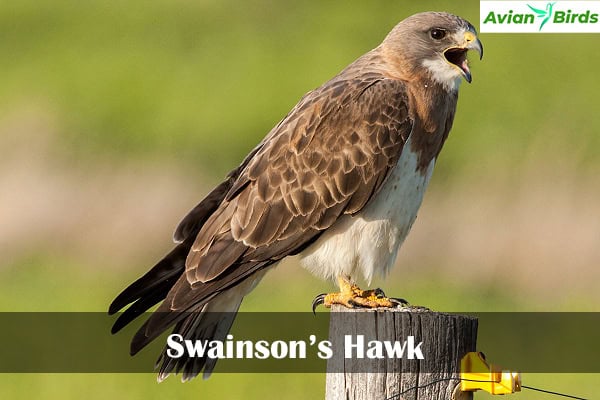
Migratory Patterns
The Swainson’s Hawk migration is a wonder to see. They fly in large groups over thousands of miles. This journey helps them find places with lots of insects to eat, which is vital for their survival.
They prefer open areas for migration because they offer many chances to catch insects. Swainson’s Hawks use thermals to go up high. This lets them fly long distances with little effort.
| Migration Route | Distance Traveled (One Way) | Breeding Grounds |
|---|---|---|
| North America to South America | Up to 6,000 miles | Grasslands and open fields |
| Central Canada to Argentina | Approximately 4,500 miles | Wetlands and agricultural areas |
Learning about the Swainson’s Hawk migration helps us understand their lives better. By knowing their amazing journeys, we can help protect their homes. This is key to their survival and happiness.
5. Northern Harrier
- Scientific Name: Circus hudsonius
- Size: 40–51 cm (16–20 in)
- Weight: 0.3–0.5 kg (0.66–1.1 lb)
- Diet: Small mammals, birds, and reptiles, often hunted in open fields.
The Northern Harrier is a standout among hawks. It has distinct physical traits and hunting behavior. It measures 16-20 inches long with wingspans of 38-48 inches. These features make it a top predator.

Physical Distinctions
Its owl-like facial disc is a key feature. It helps the Northern Harrier hear and hunt better. Males have beautiful gray feathers, while females have streaked brown ones. This difference in appearance shows the species’ variety.
Their long wings are not just for looks. They help the Northern Harriers glide and soar over open areas. This is where they hunt.
When hunting, the Northern Harrier flies low over the ground. They look for prey in grasses and fields. Their sharp eyes and ears help them spot movement. This skill makes them experts in their habitat.
6. Ferruginous Hawk
- Scientific Name: Buteo regalis
- Size: 50–65 cm (20–26 in)
- Weight: 1.4–2.5 kg (3.1–5.5 lb)
- Diet: Small mammals, particularly rodents.
The Ferruginous Hawk is the biggest raptor in North America. It is known for its large size, measuring 22-27 inches long. Its wingspan can reach from 52 to 60 inches. This bird has rusty-colored legs and shoulders with white underparts, making it easy to spot in the wild.

Size and Diet
This bird mainly eats small mammals, especially prairie dogs. Its diet is key to surviving in grasslands. Watching the Ferruginous Hawk hunt shows how it adapts to its environment.
Breeding Habits
The breeding habits of the Ferruginous Hawk show a unique social life. Also, They perform aerial displays during mating, showing off to potential mates. They often return to the same nesting spots every year.
They build large nests on cliffs or in tall trees, sometimes with other birds. This behavior shows their strong social bonds and protects their young during breeding.
7. Red-shouldered Hawk
- Scientific Name: Buteo lineatus
- Size: 40–60 cm (16–24 in)
- Weight: 0.5–1.4 kg (1.1–3.1 lb)
- Diet: Small mammals, birds, and amphibians.
The Red-shouldered Hawk is known for its beautiful looks and interesting ways. It is 17 to 24 inches long with a wingspan of 37 to 43 inches. It has reddish-brown shoulders and makes loud sounds. Let’s explore their behavior, especially in the breeding season, to see their unique traits.
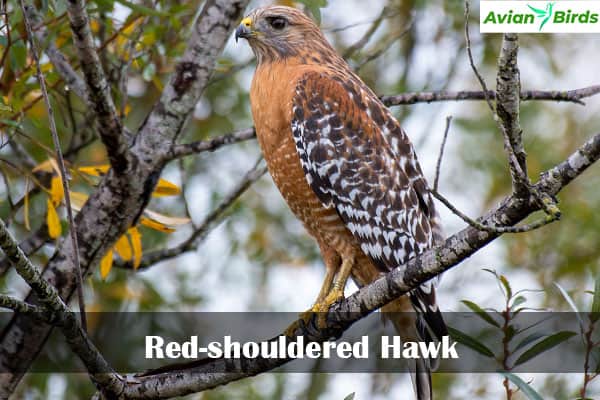
Behavior and Calls
In the breeding season, the Red-shouldered Hawk shows off with aerial displays and defends its territory. They make loud “kee-yah” calls, which are important for them in the wild. These calls help them signal their territory and talk to their mates.
They like to nest high up in trees in deciduous woodlands near water. This shows they need a good place to raise their young. Their behavior shows they are adaptable and know how to make the most of their environment for a successful breeding season.
8. Zone-tailed Hawk
- Scientific Name: Buteo albonotatus
- Size: 45–58 cm (18–23 in)
- Weight: 0.5–1.1 kg (1.1–2.4 lb)
- Diet: Small mammals, birds, and reptiles.
The Zone-tailed Hawk catches our eye because it looks a lot like the turkey vulture. It is a medium-sized raptor, measuring 17-22 inches long and having a wingspan of 43-50 inches. Its feathers help it blend in, which is key to its hunting success.

These hawks live in dry areas, where their feathers help them hide. Also, They sneak up on their prey because they are hard to see. They fly high, acting like vultures, which can trick both their prey and enemies.
They are also very good at living in different places. It’s hard to tell them apart from turkey vultures in the wild. Learning about their unique traits helps us appreciate them more.
Hawks in San Diego: A Diverse Community
Hawks in San Diego are a key part of our ecosystem’s health. It’s vital to understand how to protect them and their homes. By working together, we can help these birds and make our areas more diverse.
Conservation Efforts
Local groups are working hard to save hawks. They focus on keeping their homes safe from city growth and environmental changes. People help by joining programs that reduce dangers like destroying homes and pollution.
Exploring their Habitats
To see how diverse San Diego’s wildlife is, we must check out where hawks live. They live in places from wetlands by the coast to high mountains. Each place has its own hawk species, showing how these birds adapt. By going on hikes, birdwatching, or tours, we learn more about these places and why saving hawks is important.
| Habitat Type | Common Hawk Species | Characteristics |
|---|---|---|
| Coastal Areas | Red-tailed Hawk | Large size, powerful build; prefers open fields |
| Mountain Regions | Cooper’s Hawk | Medium-sized; adept in wooded areas and urban settings |
| Grasslands | Ferruginous Hawk | Large wingspan; hunts small mammals |
| Urban Areas | Sharp-shinned Hawk | Smallest hawk; thrives in suburban environments |
Conclusion
As we wrap up our look at the top 10 hawk species in San Diego, it’s clear these birds are key to our ecosystem. They make our landscapes more beautiful and help keep the ecosystem healthy. Hawks control rodents and other pest populations, helping farmers and wildlife alike.
It’s important to appreciate wildlife to connect more with nature. We urge everyone to watch these amazing raptors in their natural spots. Seeing a Red-tailed Hawk soar or a Cooper’s Hawk hunt teaches us about wildlife and their roles in our world.
Thinking about the role of these raptors makes us realize we must protect them. Supporting conservation efforts means future generations can also enjoy watching hawks in San Diego. By helping protect their homes and joining preservation projects, we all help keep our ecosystem thriving.


